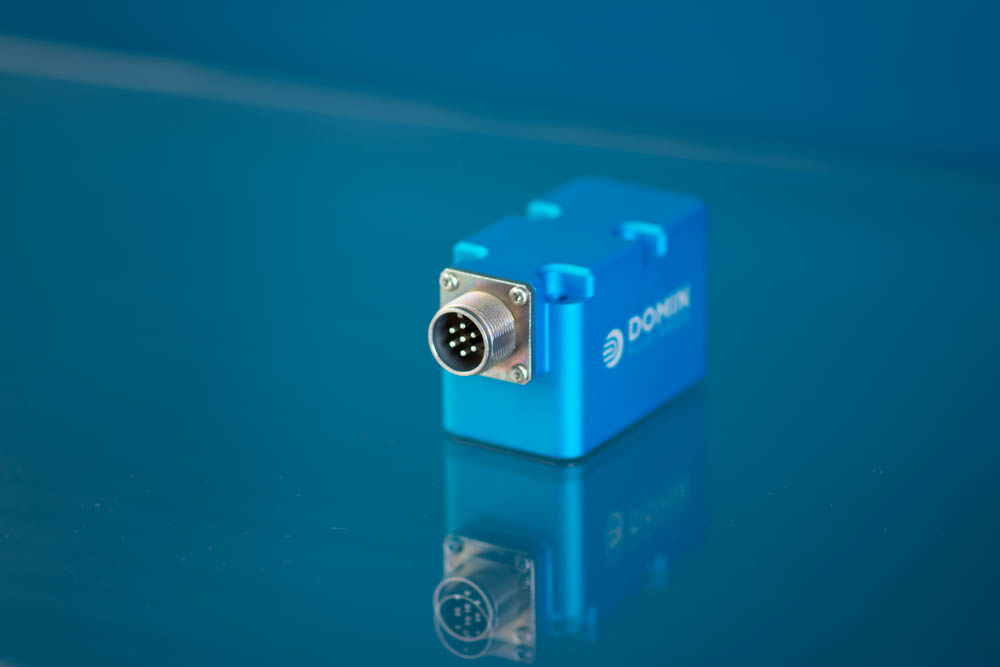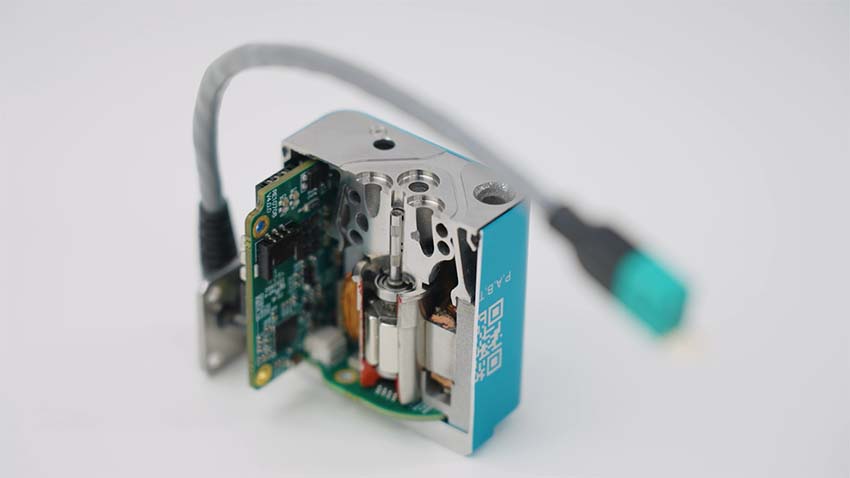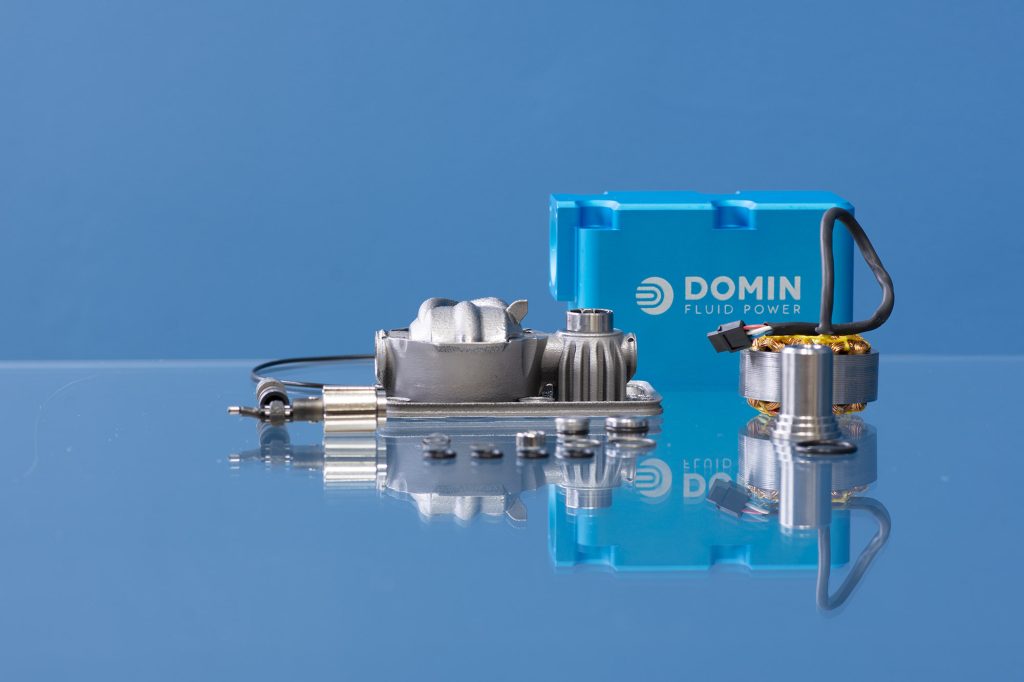Domin was built on the foundations of many years of in-depth research into next-generation hydraulic valve technology. The founders, Andrew Collins and Marcus Pont tested and developed the concepts for the future of hydraulic systems. They defined the art of the possible for the electrification of hydraulics and how the products could be installed into any industry. The idea grew into a reality and, in 2019, the company launched its first product to market. Focus, delivery, and expertise has turned the idea into a company with a robust growth trajectory.
Interview with Marcus Pont, CEO of Domin.
Easy Engineering: A brief description of the company and its activities.
Marcus Pont: We have a team of experienced engineers supported by a group of leading investors. We have a mature technology team with design, electronics, product validation, and product development expertise. They are supported by a digital team, developing software to support our hardware product development. And finally, enabled by the manufacturing team, who are responsible for taking our products to production. We are realising the potential of the ground-breaking technology with a technically led sales and marketing team.
We are an outcome driven business and lead discussions and projects with this in mind. It is critical that we behave in a way that is in line with our company values. People are the core of who we are, and these values represent the key principles with which we act. Our teams engage in critical thinking to envision better ways of doing things. We assume responsibility for things we have created or been given. We are willing to try new things, quickly recover from failure, and learn from their experiences. It is from this base and by asking a different question on how energy should be used that we were enabled to develop novel technologies that will redefine industries, reduce energy waste, and save 15 tonnes of carbon for each servo valve sold. We have the potential to make a significant reduction to the world’s energy consumption and carbon emissions.
E.E: What are the main areas of activity of the company?
M.P: At Domin, we develop and manufacture high performance hydraulic systems. This includes high-performance servo valves, active suspension, flight controls, a brake-by-wire systems.
Our high-performance hydraulic Valves, with patented Rotary Valve Technology, have been developed using cutting-edge technologies including Additive Manufacturing, brushless DC motors, and onboard electronics.
We have gone back to the drawing board and created a completely new design for the world’s smallest direct drive valves, which deliver a zero-compromise hydraulic control product.
Our direct-drive servo valves are as small or smaller than two-stage valves but with benefits of cutting-edge onboard electronics and energy efficiencies.

The core elements for our innovation are:
- Architectural engineering design to create small perfectly manufactured hydraulic valves, using the multi-disciplinary capabilities of our design engineers, making use of CAD integrated analysis tools to quickly iterate the product design and find the best compromise to suit both structural and flow requirements.
- Novel direct drive rotary valve solution, using a rotary motor and rotary spool that creates advanced high-speed hydraulic control.
- Using additive manufacturing to create compact structures that have very low-pressure loss, making the fluid’s journey as easy as possible. In addition, additive manufacturing allows us to print small structures that have inbuilt bi-directional flexibility.
We have multiple patents in this area to date, covering valve technology and system integration architectures.
We have developed next-generation actuation and control technology will help the aerospace market make the transition to the More Electric architecture. Our electro-hydrostatic actuation technology is less than half the weight of equivalent EMAs, and finally enables the removal of the central hydraulic system, with the potential for 550 kg weight saving per aircraft.
Our active suspension systems enable true independent four-corner electric actuation and will be a key route to energy-optimised vehicles across the automotive industry. The Domin system removes centralised systems and deliver high-bandwidth, four-corner control of your vehicle. Minimising energy losses throughout a drive cycle, allowing you to go further, faster, in more comfort, giving the highest performing solutions on the market, with the potential for 25% more range.
E.E: What are the ranges of products?
M.P: We have four core product ranges currently on the market or in development.
1. Hydraulic servo valves, of which there are currently 4 in the range:
S4 Pro: The Domin S4 Pro series of servo proportional valves are lightweight, high-performance directional flow control valves that cover a range of rated flows from 0.7 l/min to 18 l/min up to a maximum pressure of 350 bar per spool land.
Based on a miniature port circle of 12.2 mm and with a weight of less than 300g, the S4 Pro is suited to applications requiring superior performance, dynamics and reliability expected of a proportional valve in an ultra-compact package.
S6 Pro: The Domin S6 Pro servo proportional valve has been designed to achieve the best characteristics from two competing valve technologies: fluid amplified electrohydraulic valves and proportional valves.
The S6 Pro has the size, mass, and dynamic capabilities of the most compact electrohydraulic valves, and the low quiescent leakage and reliability of the best proportional valves.
S6 Pro X: The Domin S6 Pro X servo proportional valve builds upon the benefits of the S6 Pro. Notably, the S6 Pro X is available in two versions: voltage-controlled and current-controlled, providing greater flexibility in its application.
Based on the S04 port pattern and weighing less than 800 g, the valve has a rated flow of 63 litres per minute. It offers unparalleled performance for a variety of demanding applications.
S10: The Domin S10 Pro is a single-stage servo proportional valve which combines high flow, excellent dynamics, strong chip shear, and low power consumption.
The S10 Pro has been designed to sustain high bandwidth operation at exceptional flows without significant limitation of operating pressures or duty cycles. Where servo proportional valves have been employed to control high flows there is a clear trade with packaging size and weight. The S10 Pro valve is packaged to be lower weight and more compact than the best of electrohydraulic servo valves.
2. Active Suspension
A world-class system, enabling true independent four-corner electric actuation, and the route to energy-optimised electric vehicles.
Save weight – Removal of electronic anti-roll control, adaptive damping and springs saves >40kg per vehicle.
Extend range – Enables lower coefficient of friction tyres, ride height adjustment, reduction of electrical power consumption for 10% range extension over WLTP
Minimise energy use – Average power consumption <5W per corner, including roll control.

3. Flight Controls
Class-leading performance at a fraction of the energy consumption of competing technologies, with 28 V operation possible.
Remove the central hydraulic system, saving 550 kg per aircraft, enabling you to build lighter, faster, more efficient aircraft.
4. Brake-by-wire
Brake-by-wire technology enables significant reductions in energy use and step-change increases in performance and comfort enable the removal of centralised systems.
E.E: At what stage is the market where you are currently active?
M.P: The hydraulics industry has remained unchanged for 70 years, with no significant change to hydraulic design since Moog made big leaps forward for the technology in the 1950s. Progress that has been made within the industry has been done by adding new software to existing hardware. This has resulted in only small steps forward for efficiencies and technological advancement.
As a result, the market is at a stage of flux, with outdated technology has started to be replaced with modern, cutting-edge options. Domin is at the forefront of this change and is driving the revolution with its solutions.
While our products can be used across any industry that uses hydraulics systems, we currently work within three main industries:
- Aerospace
- Automotive
- Industrial manufacturing
All of these industries are well established. More details of the markets and market sizes are below.
E.E: What can you tell us about market trends?
M.P: Market trends that are relevant to our products and core markets include:
Aerospace
The aerospace industry is moving rapidly to replace centralized hydraulic and pneumatic systems on aircraft with electrical systems. This “More Electric Aircraft” trend is critical for achieving sustainability goals and reducing carbon emissions.
By replacing traditional power systems with digital electronic controls, aircraft can reduce weight, improve reliability, and reduce fuel consumption. Electrical actuators are lighter and can be distributed throughout the aircraft instead of having centralized hydraulic pumps.
Major manufacturers like Airbus and Boeing have set targets to reduce emissions by over 50% by 2050. More electric aircraft designs and new hybrid-electric propulsion concepts will be essential to meeting these goals.
Key innovations enabling this transition include advanced digital control electronics, smart actuator motors, and new system architectures optimized for electrical power. New standards for voltage, current, and fault monitoring are also being implemented across the industry to support these changes.
With air travel projected to continue growing, the shift towards more electric and zero-emission aircraft is crucial for the aerospace industry to reduce its environmental impact and meet sustainability objectives in the coming decades.
Automotive
Active suspension systems are becoming more common in high-end and luxury vehicles. These systems use sensors and actuators to independently adjust the stiffness of each wheel in real-time to improve ride quality and handling. Mercedes, BMW, Audi, and other luxury brands now offer active suspension on many models. Lower cost active systems from suppliers like ZF and Bosch are also entering the mainstream market.
Four-wheel steering is also gaining traction, allowing the rear wheels to turn slightly for better maneuverability and stability. It has moved from only being offered on exotic sports cars to more mainstream vehicles like Honda, Porsche, and Ford models. Four-wheel drive systems that can vary torque between front and rear axles are also increasingly common to improve traction and performance.
Overall, automakers are rapidly adopting advanced suspension and drivetrain technologies thanks to falling costs and consumer demand for improved comfort, safety, and performance. Key trends are lighter-weight designs, independently controlled wheels, and all-wheel drive systems that optimize power delivery. Advanced driver aids like collision avoidance and self-parking rely on these advanced chassis and drivetrain systems as well.
Industrial manufacturing
Industrial manufacturers are modernizing systems and processes to reduce waste, cut costs, and meet sustainability goals. Upgrading from inefficient hydraulic and pneumatic systems is a key focus area.
Many older manufacturing plants still rely on centralized hydraulic power units that are maintenance-intensive, inflexible, and energy-intensive. Newer electrical actuation systems powered by smart digital controls are much more energy efficient. They also enable better monitoring, control, and flexibility on the factory floor.
Leading companies like Siemens, Emerson, and Bosch Rexroth offer innovative electro-mechanical actuator systems that are plug-and-play replacements for hydraulic cylinders. They provide precision motion control without costly hydraulic supply lines.
Adoption of servo motors, drives, and intelligent software control platforms is on the rise. These technologies optimize energy use and allow centralized control of distributed manufacturing assets.
Sensors, IoT connectivity, and analytics are also being layered on to provide real-time insights for predictive maintenance and to identify additional efficiency gains.
The trend toward electric, connected, and data-driven manufacturing is accelerating. Companies that upgrade outdated systems can see significant cost and energy savings, in addition to more agile operations.

E.E: What are the most innovative products marketed?
M.P: All Domin products are built on the following core innovations:
- Architectural engineering design to create small perfectly manufactured hydraulic valves, using the multi-disciplinary capabilities of our design engineers, making use of CAD integrated analysis tools to quickly iterate the product design and find the best compromise to suit both structural and flow requirements.
- Novel direct drive rotary valve solution, using a rotary motor and rotary spool that creates advanced high-speed hydraulic control.
- Using additive manufacturing to create compact structures that have very low-pressure loss, making the fluid’s journey as easy as possible. In addition, additive manufacturing allows us to print small structures that have inbuilt bi-directional flexibility.
These innovations are found in our hydraulic valves, active suspension, flight controls, and brake-by-wire systems.
The result is higher performing and more energy efficiency systems that are fundamentally different from any existing technology.
We are using worldclass design and cutting-edge manufacturing technology to revolutionise industries with our ground-breaking hydraulic products. We are defining Digital Motion Control with a novel approach to electrically signalled electrically controlled distributed movement with electrified hydraulic power generation systems that increase efficiencies of systems up to 90% and will save 1 gigaton of CO2 every year by 2030.
We have many patents protecting the innovative technology that we design and manufacture, including:
| Patent No | Title | Status | Markets Covered |
| GB2510498 | Servo Valve Manifolds | Granted in UK, USA, Sweden, Italy, Germany, France, Spain, Poland and the Netherlands | Servo valves ($1B) |
| GB2581162 | Rotary Servo Valve | Granted in UK and USAPending in EU and China | Small servo valves ($100M)Suspension ($60B)Braking systems ($30B) |
| GB2547863 | Improvements in and relating to servo valves | Granted in UK | Large servo valves ($250M) |
| GB2584970 | Improvements in and relating to servo valves | Granted in UK | Large servo valves ($250M) |
| GB2522744 | Servo Actuators | Granted in UK and USA | Flight control actuation ($9B) |
| GB2581160 | Rotary servo valve | Granted in UK | Large servo valves ($250M) |
And have submitted the patents below, of which we are waiting confirmation:
| Patent No | Title | Status | Markets Covered |
| GB2606519 | Common pump and rotor motor | Published in UKPCT application filed for international protection | Suspension ($60B)Braking systems ($30B) |
| GB2606389 | Multifunction pintle | Published in UKPCT application filed for international protection | Suspension ($60B)Braking systems ($30B) |
| GB2611506 | Multi-stage pump | Published in UKPCT application filed for international protection | Suspension ($60B)Braking systems ($30B) |
| GB2606391 | High-pressure Active Suspension System | Published in UKPCT application filed for international protection | Suspension ($60B) |
| GB2614293 | High-speed rotary-linear digital switching valve | Published in UKPCT application filed for international protection | Mobile hydraulics ($27B) |
| GB2206454.7 | A hydraulic device and a hydraulic system for controlling a hydraulic actuator | Filed in UK | Mobile hydraulics ($27B) |

